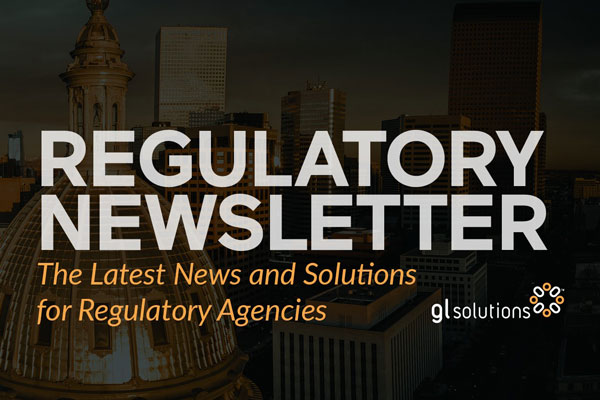If you’re a licensing professional, public safety is your business.
The public counts on you to prevent unqualified people from becoming licensed as nurses, lawyers, cosmetologists, accountants or any other professional your legislature regulates. Licensed professionals account for 20% of the United States’ workforce. Some of your state’s most vulnerable people rely upon agencies like yours to screen applicants and to administer and issue licensure, to perform timely inspections and to follow up with investigations and appropriate enforcement actions.
Lessons in the importance of licensure and effective oversight are never far away, from headlines about illegal child care facilities to news about unlicensed home builders. Protecting the public from unscrupulous people poses a challenge under any circumstance. But it’s particularly difficult when your regulatory agency must rely on paper processes and legacy systems. Automate your regulatory agency’s business process to help speed up data entry and eliminate common mistakes that allow bad actors to slip through the cracks and unsafe conditions to persist.
Learn five tools to use at your regulatory agency to better protect the public—and help your agency fulfill its public-safety mission.
Conduct background checks
Few things your agency does are more important than performing background checks on people seeking licensure. Failing to get this right harms the public and your agency’s reputation.
In 2019, an Iowa Auditor of State investigation determined that the Department of Public Safety had failed to conduct nationwide background checks before issuing more than 5,800 licenses to private investigators, security guard and bail enforcement officers. As a result, as many as 25 people received “guard card” licenses despite having been charged with aggravated misdemeanors or felonies. Such charges disqualify candidates from licensure.
Automated interfaces
To help your regulatory agency protect the public and avoid a similar fate, turn to automated interfaces with background check vendors across the country, including the FBI and state bureaus of investigation. Automation allows background data to flow into your regulatory system on whatever schedule your agency requires, ensuring up-to-date and accurate information. To facilitate timely processing, notify staff automatically when you receive that background-check information.
CJIS-compliant
Ensure you use a CJIS-compliant vendor for your regulatory system. A CJIS-compliant vendor meets data security standards from the Criminal Justice Information Center.
How GL Solutions’ clients use our interfaces and system to protect the public:
- The Connecticut Department of Emergency Services and Public Protection uses background checks to ensure that felons, the mentally ill and others not legally allowed to buy or own firearms do not do so.
- The Kansas Department for Aging and Disability Services uses background checks to confirm that licensed nurses have not engaged in activity that would preclude them from working with patients.
- The Virginia Department of Behavioral Health and Developmental Services uses background checks to review facility staff.
Track historical data
Bad actors sometimes try to secure licenses or register new businesses by using aliases, new business names and different addresses. If your agency lacks a system that tracks historical data – and especially if it lacks a system at all – foiling such attempts to fool regulators can be extremely difficult. When children get hurt or guns end up in the wrong hands, your agency’s reputation inevitably suffers.
Use your regulatory system to track previous data across records and make all of it available for review and reporting. Such data include names, addresses, licenses, permits and contracts. Track any deleted or changed information in the system. These tracking logs help your agency maintain a visible and reportable audit trail for certain types of records.
Easily meet data retention policies by storing data in the cloud, through Microsoft Azure—also FedRAMP certified.
How historical data tracking helps GL Solutions clients:
- The Kansas Department for Aging and Disability Services uses prior name information along with background checks to ensure that people can’t slip through the background check system by using aliases.
- The Alaska Department of Commerce, Community and Economic Development, which conducts enforcement for more than 20 state boards, uses tracking of historical data to identify repeat offenders.
Track application and renewal requirements
Applicants for licensure and renewal must meet stringent requirements, including the submission of documents and other information demonstrating their professional expertise. Keeping track of this information manually, especially in the time of universal licensing, joint compacts and reciprocity agreements, can be difficult and time consuming.
Meanwhile, applicants want to know how the process is going and when their certifications and licenses will be issued. Caught between the need to track detailed requirements and pressure from eager applicants, staff sometimes issue licenses prematurely or without following the proper procedures.
When this happens, public safety is compromised. So is your agency’s reputation.
Consider the 2019 conundrum facing the Texas Alcoholic Beverage Commission and Kaufman County clerk. During the previous year, a business filed a package store application with the clerk’s office, which is the first step in applying for a license with the state beverage commission. The building that would house the package store had not yet been built, and the proposed location was just outside the Forney city limits. This location sits in a “dry” part of the county, and package stores cannot be built there.
What happened? As part of the application review process, the county clerk is required to ensure that locations for licenses and permits are in “wet” areas. The clerk’s office did not take that step and accidentally certified the proposal and sent it to the state beverage commission, which issued the permit. The state later recognized the clerk’s error, but refused to revoke the license once issued. The county subsequently opted to go to court to prevent the completed package store from selling liquor.
Functionalities that support requirements tracking
- Interactive business process guides, integrated into your regulatory system, lead staff through application and renewal processes, ensuring consistency and accuracy. These replace antiquated manuals—and three-ring binders.
- Automated workflow rules prevent applications from being approved until all requirements are met.
- Workflow rules can include supervisor or other staff to ensure accuracy.
- Supervisors see staff work queues and may reassign work for greater efficiency.
- The system automatically notifies appropriate staff when tasks are ready to process.
- Regulatory software notifies applicants immediately when their application or renewal get accepted.
How GL Solutions’ clients use automated application tracking functionality:
- Medical boards, such as the Arizona Board of Medicine, track more than 25 requirements such as work history, medical school records and personal recommendations. Automatic tracking reduces errors and processing time.
- The Virginia Department of Behavioral Health and Developmental Services tracks foster care and child care facilities applicants, requiring both a lot of information, as well as inspections to process.
Conduct investigations and enforcement
A licensing agency’s job doesn’t end when a license or renewal is issued. To protect the public, an agency must investigate facilities and programs following failed inspections. It also must take appropriate enforcement actions to improve conditions or, when necessary, revoke licenses and permits. Failing to conduct investigations and enforcement actions properly can allow unsafe conditions to persist and cast your agency in a bad light.
Despite their importance, investigations and enforcement actions are commonly mishandled. Some agencies lack the necessary process documentation, and others do not have a system that supports the scheduling and automated tracking needed to conduct investigations and enforcement efficiently.
Choose a regulatory system that automates the key components of inspections, investigations and enforcement actions, reducing errors and processing time while enhancing consistency.
Looks for these features in a regulatory system:
- Schedule, track and execute any type of inspection or reinspection.
- Set up automatic inspection scheduling according to agency needs.
- Track requirements that need to be revisited.
- Allow fully paperless inspections using a mobile inspection application.
- Take and save pictures, audio and video files.
- Enable GIS functionality to track inspection location, including remote processing without Wi-Fi.
- Create enforcement cases from investigations and inspections.
- In enforcement, associate all involved licensees, attorneys and others.
- Assign staff to enforcement cases.
- Generate letters and notifications to complainants and others related to enforcement cases.
- Track and manage appeals of board decisions and orders.
- Generate workflow that guides a case or complete from initiation to enforcement, identifying the milestone along the way—investigation, hearings, board meetings and more.
How GL Solutions’ clients conduct investigations and enforcement:
- The West Virginia Alcohol Beverage Control Administration automatically schedules re-inspections when liquor stores fail to pass inspections.
- Cosmetology and barbering boards such as the Alabama Board of Cosmetology and Wyoming Board of Cosmetology follow enforcement procedures to ensure that individuals and businesses comply with requirements that result from failed inspections.
- Alaska’s Division of Business Corporations and Professional Licensing uses a centralized investigation/case management team that supports boards and departments. Daily, they intake complaints, process cases and conduct investigations that lead to enforcement.
Provide verification websites
Regulatory agencies help keep the public safe by keeping them well-informed. Many licensing agencies meet this obligation by making information about their licensees available on public-facing websites. Such sites are invaluable sources of information for people looking for qualified building contractors or checking the disciplinary histories of doctors and lawyers.
When making such information available, however, it’s crucial to ensure that it’s accurate and up-to-date. Websites that display incorrect or incomplete information can lead the public astray when hiring medical practitioners and other professionals. Inaccurate information also can harm the reputations of your licensees. Meanwhile, reports of incorrect information can consume staff time and anger your agency’s board.
Verification sites need to go beyond simply license status and data obtained. The public—especially for childcare facilities—need to see inspection results and correction action plan measures from these businesses to ensure public safety.
How GL Solutions’ clients use verification websites:
- The Oklahoma Construction Industries Board uses a verification site to allow the public to search for building contractors.
- The Minnesota Board of Cosmetology uses a verification site to allow the public to search for salons and professionals.
Licensing and Permitting Solutions
GL Solutions guides you in modernizing your regulatory agency with automated digital licensing and permitting solutions tailored to your unique needs. Learn more on our website about our licensing and permitting regulatory solutions.
Run, Grow and Adapt
Subscribe to our newsletter to receive the latest regulatory news delivered to your inbox each week.
GL Solutions helps governments run, grow and adapt. To learn more, explore our website, call us at 800.930.1193 or email us at hello@glsolutions.com.


